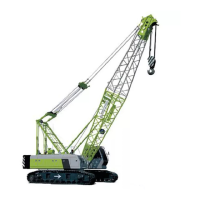Safety
Operator’s Manual for Crawler Crane
1.2 Component safety features
a) Do not use this crane with guards removed or incorrectly fastened.
b) Do not use this crane with safety devices maladjusted or removed.
1.3 Features for operator safety
a) Safety component – crane emergency stop button. Ensure all safety components are in
place.
b) Support plates, handrails, tread plates and fixed guards are provided to assist the
personnel to climb on the crane.
1.4 Environmental safety
a) A regular service should be taken on the crane strictly in accordance with maintenance
procedures to ensure that engine emission is close to a minimum value.
b) Consumable materials
1) The spilling diesel must be dealt with immediately.
2) Only use the lubricating oil recommended in the Maintenance Manual.
3) Local and national regulations must be observed strictly when disposing of the waste.
4) Improper disposal of the waste is illegal, as it will undermine the environment.
5) Potentially harmful waste used on this crane includes such items as hydraulic oil, fuel,
coolant, filters and batteries, etc.
6) Use leak-proof containers for draining the fluids. Do not use food or beverage
containers that may mislead someone into drinking or eating them.
7) Do not pour the waste into the ground, into sewer system or into any water source.
8) Ensure that all consumable and replaced parts are disposed of safely and with
minimum environmental impact.
c) Machine disposal. This machine must only be disposed of by a special machine breaker.
1.5 Personnel protective equipment (PPE)
a) Loose or baggy clothing can get caught in running machinery.
b) Where possible when working close to the engine or machine, only do so when they are
stopped. If this is not practical, remember to keep tools, test equipment and all other parts
of your body away from the moving parts.
c) For reasons of safety, long hair must be tied back or otherwise secured. The garments
must be close fitting and no jewellery such as rings may be worn.
d) Correctly wear personnel protective equipment.
e) Recommended personnel protective equipment includes:
1) Hard hat
1-2

